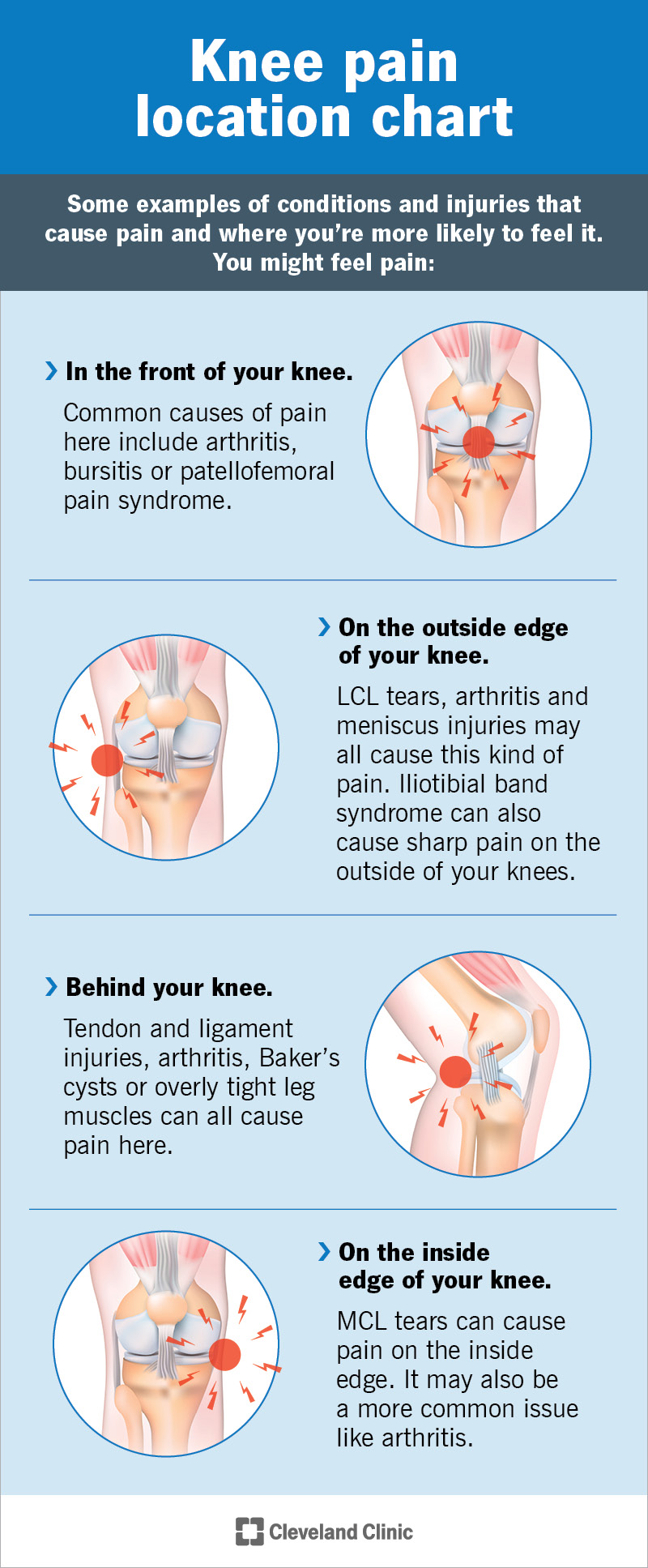Knee pain is an extremely common symptom. Lots of issue can cause it. It may be a temporary injury or chronic condition like arthritis. You can usually treat knee pain at home with rest and over-the-counter medicine. Visit a healthcare provider if you’ve experienced an injury or have knee pain for more than a few days in a row.
Advertisement
Cleveland Clinic is a non-profit academic medical center. Advertising on our site helps support our mission. We do not endorse non-Cleveland Clinic products or services. Policy

Knee pain is discomfort you feel in or around your knee joint.
Advertisement
Cleveland Clinic is a non-profit academic medical center. Advertising on our site helps support our mission. We do not endorse non-Cleveland Clinic products or services. Policy
Joints are places in your body where two bones meet. Your knee joint connects your thigh to your lower leg. It’s where your thigh bone meets your shin bone.
The knee is the biggest joint in your body, and it absorbs and supports a lot of your weight as you move. That’s why it’s one of the most commonly injured joints. Knee joint pain can be a temporary, short-term problem, but it can also be a chronic (long-term) issue.
Knee pain can come and go. For example, you might feel pain when you’re moving or bending your knee. But it might get better when you rest. Some people also feel pain at different times of the day. You could feel more pain first thing in the morning when you wake up. It’s also common to feel pain in your knee at night, especially if you were physically active earlier that day.
You can usually treat knee pain at home with over-the-counter (OTC) pain relievers and by taking a break from physical activities.
The most common causes of knee pain include:
Advertisement
Lots of issues can cause knee pain. It can be hard to narrow down a cause on your own. Where your knee hurts can be a good sign of what’s causing it.
Take a look at the chart. It shows some examples of conditions and injuries that cause knee pain and where you’re more likely to feel it. You might feel pain:
Your knees are a complex joint. And everyone’s body is different. You might have a different injury or condition from the examples here. Seeing a healthcare provider is the only way to know for sure. Use this chart as a guide when you visit a provider. The more specific you can be, the better. Tell your provider:
A healthcare provider will suggest treatments to treat knee pain based on its cause and how much it hurts. Some treatments include:
Advertisement
The best way to prevent pain is to stay safe when you’re physically active. During sports or other physical activities:
Follow these general safety tips to reduce your risk of injury:
Visit a healthcare provider if you have:
Go to the emergency room or call 911 (or your local emergency services number) if you’ve experienced a trauma like a car accident or severe fall. Go to the ER if you can’t move your knee or leg, or if you think you have a broken bone.
Knee pain is so common that almost everyone has felt it. But that doesn’t mean you have to live in constant pain. Visit a healthcare provider if knee pain is bad enough to make you change your daily routine. They’ll help you find treatments that get you back to what you love.
Advertisement
Trust your instincts and listen to your body. People sometimes assume that knee pain is just a part of getting older or an unavoidable side effect of their jobs or activities. You might feel pain every once in a while, but don’t ignore it if it lasts more than a few days in a row.
Advertisement
Knee pain can keep you from doing the things you love. Cleveland Clinic experts can craft a treatment plan to get you back to the regular pace of your life.

Last reviewed on 07/20/2025.
Learn more about the Health Library and our editorial process.